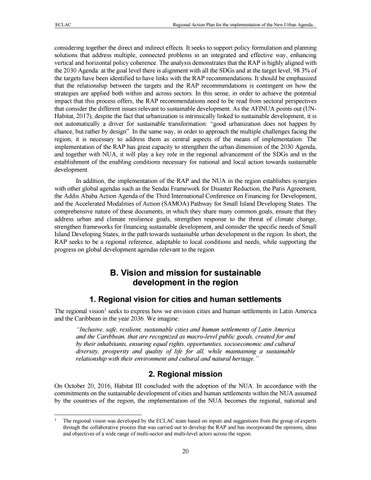ECLAC
Regional Action Plan for the implementation of the New Urban Agenda...
considering together the direct and indirect effects. It seeks to support policy formulation and planning solutions that address multiple, connected problems in an integrated and effective way, enhancing vertical and horizontal policy coherence. The analysis demonstrates that the RAP is highly aligned with the 2030 Agenda: at the goal level there is alignment with all the SDGs and at the target level, 98.3% of the targets have been identified to have links with the RAP recommendations. It should be emphasized that the relationship between the targets and the RAP recommendations is contingent on how the strategies are applied both within and across sectors. In this sense, in order to achieve the potential impact that this process offers, the RAP recommendations need to be read from sectoral perspectives that consider the different issues relevant to sustainable development. As the AFINUA points out (UNHabitat, 2017), despite the fact that urbanization is intrinsically linked to sustainable development, it is not automatically a driver for sustainable transformation: “good urbanization does not happen by chance, but rather by design”. In the same way, in order to approach the multiple challenges facing the region, it is necessary to address them as central aspects of the means of implementation. The implementation of the RAP has great capacity to strengthen the urban dimension of the 2030 Agenda, and together with NUA, it will play a key role in the regional advancement of the SDGs and in the establishment of the enabling conditions necessary for national and local action towards sustainable development. In addition, the implementation of the RAP and the NUA in the region establishes synergies with other global agendas such as the Sendai Framework for Disaster Reduction, the Paris Agreement, the Addis Ababa Action Agenda of the Third International Conference on Financing for Development, and the Accelerated Modalities of Action (SAMOA) Pathway for Small Island Developing States. The comprehensive nature of these documents, in which they share many common goals, ensure that they address urban and climate resilience goals, strengthen response to the threat of climate change, strengthen frameworks for financing sustainable development, and consider the specific needs of Small Island Developing States, in the path towards sustainable urban development in the region. In short, the RAP seeks to be a regional reference, adaptable to local conditions and needs, while supporting the progress on global development agendas relevant to the region.
B. Vision and mission for sustainable development in the region 1. Regional vision for cities and human settlements The regional vision1 seeks to express how we envision cities and human settlements in Latin America and the Caribbean in the year 2036. We imagine: “Inclusive, safe, resilient, sustainable cities and human settlements of Latin America and the Caribbean, that are recognized as macro-level public goods, created for and by their inhabitants, ensuring equal rights, opportunities, socioeconomic and cultural diversity, prosperity and quality of life for all, while maintaining a sustainable relationship with their environment and cultural and natural heritage.”
2. Regional mission On October 20, 2016, Habitat III concluded with the adoption of the NUA. In accordance with the commitments on the sustainable development of cities and human settlements within the NUA assumed by the countries of the region, the implementation of the NUA becomes the regional, national and 1
The regional vision was developed by the ECLAC team based on inputs and suggestions from the group of experts through the collaborative process that was carried out to develop the RAP and has incorporated the opinions, ideas and objectives of a wide range of multi-sector and multi-level actors across the region.
20
